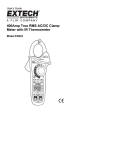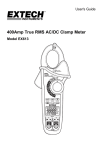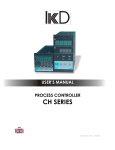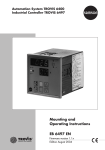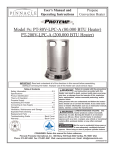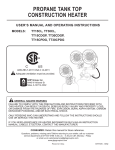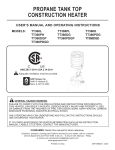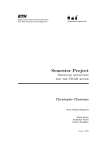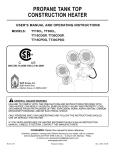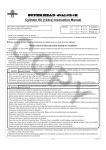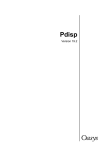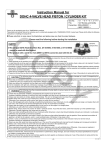Download "user manual"
Transcript
ETM-100 NON-TSO ENGINE TEMPERATURE MONITOR USER'S MANUAL Adaptive Interfaces, Inc. 2013 The ETM-100 is not certified by the FAA and is intended for use only in Homebuilt, Experimental or Ultralight aircraft. Any questions pertaining to the use of this instrument in a particular aircraft should be addressed to your local aviation authorities. It is the responsibility of the aircraft pilot to be thoroughly familiar with the operation of the ETM-100 and know its limitations. Correct installation of this instrument should be verified by a qualified avionics facility. TABLE OF CONTENTS PAGE INTRODUCTION 1 SCOPE DESCRIPTION SPECIFICATIONS 1 1 1 BUTTON FUNCTIONS 2 INDICATORS 2 MENUS OVERVIEW 3 MENUS QUICK REFERENCE MAIN MENU (MENU 0) FUNCTIONS F C MENU 1 FUNCTIONS br (DISPLAY BRIGHTNESS CONTROL) Ad (AUTO DIMMER FUNCTION) UPd (Display Update Period) rES (Display Resolution) EG (EGT Sensor and Display On/Off) CH (CHT Sensor and Display On/Off) MENU 2 FUNCTIONS - ALARMS EGT Alarm Settings CHT Alarm Settings MENU 3 FUNCTIONS - INSTRUMENT ADJUSTMENTS Cold Cal - Ice Bath Temperature Setting EGT C 0 and CHT C 0 - Thermocouple Input Zero Settings SPECIAL FUNCTION Lo E (LOW VOLTAGE WARNING) - SPECIAL FUNCTION 4-6 7 7 7 8 8 9 10 11 12 13 14 14 14 15 15 16 - 17 18 18 TABLE OF CONTENTS (CONT.) ELECTRICAL CONNECTIONS POWER INPUT GROUNDS ALARM OUTPUT DISPLAY BRIGHTNESS CONTROL INPUT BACKLIGHT BRIGHTNESS CONTROL INPUT CYLINDER HEAD TEMPERATURE - TYPE-J THERMOCOUPLE EXHAUST GAS TEMPERATURE - TYPE-K THERMOCOUPLE BACK PANEL DIAGRAM 19 19 19 19 20 21 22 23 APPENDIX A INTRODUCTION SCOPE This manual provides specifications, operating instructions and installation instructions for the ETM-100 Engine Temperature Monitor. This manual is for use by persons who are familiar with aircraft, aircraft avionics, and general electronic principles. DESCRIPTION The ETM-100 Engine Temperature Monitor is a solid state instrument that displays Exhaust Gas Temperature (EGT) and Cylinder Head Temperature (CHT) on a 4-digit over 3-digit LED display. Temperatures can be displayed in english units (Degrees Fahrenheit) or metric units (Degrees Celcius). The ETM-100 uses thermocouples to measure EGT and CHT. A thermocouple is a sensor made from two different metals that generates a voltage when heated. The ETM-100 uses a single Type-J Thermocouple to measure CHT and a single Type-K Thermocouple to measure EGT. Control of the ETM-100 is by a set of 4 buttons on the front panel of the instrument. The ETM-100 is a standard 2-1/4 inch instrument and is designed to be mounted in a standard 2-1/4 inch aircraft panel cut-out. The display brightness and internal backlighting can be controlled by the user. SPECIFICATIONS Supply Voltage: Maximum Supply Current: EGT Temperature Display Range: EGT Temperature Accuracy: CHT Temperature Display Range: CHT Temperature Accuracy: EGT Sensor Type: CHT Sensor Type: 10 Vdc - 30 Vdc 350 mA 0 - 2000 Degrees F (-17 C - 1093 C) +/- 20 Degrees F 0 - 1200 Degrees F (-17 C - 649 C) +/- 20 Degrees F Type K Thermocouple Type J Themocouple Dimensions: Weight: Mounting Screws: Upper Connector: Lower Connector: H 2.40" x W 2.50" x D 1.50" 4 Oz. (114 g.) 4 ea. 6-32 x L 0.5" (Max.) 4-Pin Screw Terminal 9-Pin DSUB Female 4-40 PAGE 1 BUTTON FUNCTIONS FUNC This button is used to select and advance instrument functions for each menu level. Holding this button in for 5 seconds will cause the instrument to advance to the next menu level. When the instrument is in the MAIN MENU mode, these buttons are used to adjust the brightness of the digital display when the DISPLAY BRIGHTNESS function is set to FP (Front Panel). Otherwise, in Main Menu mode, these buttons perform no operations. In functions of MENU LEVEL 1, MENU LEVEL 2 and MENU LEVEL 3, these buttons are used to select options or to increase or decrease values of the selected function. SEL When the instrument is in the MAIN MENU mode, this button is used to deactivate the instrument's ALARM for a period of 2 minutes. In all other cases, the button is used as an "Enter" button to select and retain the value or setting of the displayed function. INDICATORS F The F indicator is lit when the instrument is displaying (EGT) Exhaust Gas Temperature and (CHT) Cylinder Head Temperature in Degrees Fahrenheit or English mode. C The C indicator is lit when the instrument is displaying (EGT) Exhaust Gas Temperature and (CHT) Cylinder Head Temperature in Degrees Celcius or Metric mode. o o PAGE 2 MENUS OVERVIEW The ETM-100 is controlled through a series of menus and functions. MAIN MENU The MAIN MENU (MENU LEVEL 0) allows the pilot to view (EGT) Exhaust Gas Temperature and (CHT) Cylinder Head Temperature in either English or Metric units. MENU LEVEL 1 - INSTRUMENT SETTINGS MENU LEVEL 1 (L1) is entered from MENU LEVEL 0 by pressing and holding the FUNC button for 5 seconds. When the ETM-100 is in MENU LEVEL 1, the user can change the instrument's optional settings. These settings include the digital display's BRIGHTNESS CONTROL mode, the AUTO DIM function, the display UPDATE PERIOD, and the DISPLAY RESOLUTION. The RETURN TO MAIN function brings the ETM-100 back to its normal operation mode, MAIN MENU. MENU LEVEL 2 - ALARMS MENU LEVEL 2 (L2) is entered from MENU LEVEL 1 by pressing and holding the FUNC button for 5 seconds. When the ETM-100 is in MENU LEVEL 2, the user can set the high-level alarms for EXHAUST GAS TEMPERATURE (EGT) and CYLINDER HEAD TEMPERATURE. Alarms can be set to OFF or to EGT values of 800 F to 1900 F and CHT values of 500 F to 900 F. Alarms are set in English units. The BACK ONE LEVEL function brings the ETM-100 to MENU LEVEL 1. The RETURN TO MAIN brings the ETM-100 back to its normal operation mode, MAIN MENU. MENU LEVEL 3 - INSTRUMENT ADJUSTMENTS MENU LEVEL 3 (L3) is entered from MENU LEVEL 2 by pressing and holding the FUNC button for 5 seconds. When the ETM-100 is in MENU LEVEL 3, the user can make fine adjustments to the instrument. The Cold CAL adjustment sets the ETM-100 to 32o F when the EGT and CHT sensors are placed in an ice bath. The EGT and CHT C 0 functions set Zero points for the instrument's thermocouple inputs. The BACK ONE LEVEL function brings the ETM-100 to MENU LEVEL 2. The RETURN TO MAIN brings the ETM-100 back to its normal operation mode, MAIN MENU. PAGE 3 MENU QUICK REFERENCE MAIN MENU (MENU LEVEL 0) oF oC ENGLISH METRIC Display Temperatures in degrees F. Display Temperatures in degrees C. PAGE 4 Press and hold FUNC button 5 seconds to advance to MENU LEVEL 1 MENU LEVEL 1 Br UPd Ad rES DISPLAY BRIGHTNESS AUTO DIMMER UPDATE FREQUENCY DISPLAY RESOLUTION Change display brightness control mode. Turn Auto Dim function On and Off. Select display update time period. Select display digits resolution. EG CH EGT SENSOR AND DISPLAY CHT SENSOR AND DISPLAY RETURN TO MAIN Turn ON or OFF. Turn ON or OFF. Return to Main Menu. PAGE 5 MENU QUICK REFERENCE (CONT.) Press and hold FUNC button 5 seconds to advance to MENU LEVEL 2 MENU LEVEL 2 - ALARMS EGA CHA EGT HIGH TEMP. ALARM Set High Alarm level in deg. F or to OFF. CHT HIGH TEMP. ALARM Set High Alarm level in deg. F or to OFF. RETURN ONE LEVEL RETURN TO MAIN Return to LEVEL 1 Return to Main Menu. Press and hold FUNC button 5 seconds to advance to MENU LEVEL 3 MENU LEVEL 3 - COLD TEMPERATURE AND ZERO SETS Cold (EGT) C O (CHT) C O 32o F TEMP. SET EGT INPUT ZERO CALIBRATION Set 0.0 V EGT Input Point. CHT INPUT ZERO CALIBRATION Set 0.0 V CHT Input Point. Ice Bath Temperature Value. PAGE 6 RETURN ONE LEVEL RETURN TO MAIN Return to LEVEL 2 Return to Main Menu. FUNCTIONS MAIN MENU (MENU LEVEL 0) FUNCTIONS F In this mode, Exhaust Gas Temperature and Cylinder Head Temperature are displayed in ENGLISH units. EGT and CHT are displayed in Degrees Fahrenheit. C In this mode, Exhaust Gas Temperature and Cylinder Head Temperature are displayed in METRIC units. EGT and CHT are displayed in Degrees Celcius. FUNC Press and release FUNC to change from F to C PAGE 7 MENU LEVEL 1 FUNCTIONS br (DISPLAY BRIGHTNESS CONTROL) FUNC SEL FUNC SEL Press and Hold FUNC button for 5 seconds until L1, then br appears on the display, then release. Press SEL button to set and store the mode. Press and release FUNC button until the Return To Main symbol appears on the display. Press the SEL button to return to the MAIN MENU. Use Up and Down buttons to select the brightness control mode. The brightness of the digital display and the indicator LEDs can be set to 16 different levels and be controlled in 3 different modes. These modes are as follows: E (EXTERNAL CONTROL VOLTAGE) An external control voltage ranging from 0V to the supply voltage is applied to pin 3 of the Lower Electrical Connector. This voltage is sampled by the ETM-100 and its ratio to the Supply Voltage is calculated into 16 levels. This allows a single potentiometer to be connected between ground and the instrument power input and used as a brightness control, its center tap used as the pin 3 input. See the ELECTRICAL CONNECTIONS section of this manual for details of the control circuit. FP (FRONT PANEL) When the ETM-100 is operating in the ALT or MC mode, the UP and DOWN buttons are used to set the display brightness. Also see the AUTO DIMMER function. PH (PHOTOCELL) The display brightness is controlled automatically by the amount of ambient light seen by the photocell on the front of the instrument. PAGE 8 MENU LEVEL 1 FUNCTIONS - CONT. Ad (AUTO DIMMER FUNCTION) FUNC FUNC SEL FUNC SEL Press and Hold FUNC button for 5 seconds until L1 appears on the display, then release. Press and release FUNC button until the Ad function appears on the display. Press SEL button to set and store the selection. Press and release FUNC button until the Return To Main symbol appears on the display. Press the SEL button to return to the MAIN MENU. Use Up and Down buttons to turn the Ad function ON and OFF. When the display brightness mode of the ETM-100 is set to FP (Front Panel) control, the photocell on the front panel can be used to automatically change the brightness of the digital display when lighting conditions change. When flying from low light (ie. clouds, dawn) to bright sunlight, the AUTO DIMMER function will raise the brightness of the digital display to a set level without the need to press the UP/DOWN buttons. When flying from bright light to low light (ie. dusk), the AUTO DIMMER function will lower the brightness of digital display to a set level. After the display brightness is changed with the AUTO DIMMER function, the display brightness can still be adjusted manually with the UP and DOWN buttons. The 2 AUTO DIMMER modes are as follows: Ad OFF The display brightness will stay at the level selected by the UP/DOWN buttons and will not change as lighting conditions change. Ad On The display brightness will raise or lower to set levels when lighting conditions change. PAGE 9 MENU LEVEL 1 FUNCTIONS - CONT. UPd (Display Update Period) DEFAULT FUNC FUNC SEL FUNC SEL Press and Hold FUNC button for 5 seconds until L1 appears on the display, then release. Press and release FUNC button until the UPd function appears on the display. Press SEL button to set and store the selection. Press and release FUNC button until the Return To Main symbol appears on the display. Press the SEL button to return to the MAIN MENU. Use Up and Down buttons to set the Display Update Period in seconds. Exhaust Gas and Cylider Head temperatures tend to stabilize at a steady cruising altitude and airspeed but they may still vary slightly. The ETM-100 samples EGT and CHT 250 times a second and displays a running average of their values. As the running averages of these values change, the new running averages are immediately available to the LED digital display. A digital display that updates with different values 250 times a second can be a distraction to a pilot. Therefore, the ETM-100 has a default setting to update its display once every 2.0 seconds. This update period can be modified from 0.5 seconds to 5.0 seconds in 0.5 second steps using the UPd function. PAGE 10 MENU LEVEL 1 FUNCTIONS - CONT. rES (Display Resolution Select) FUNC FUNC SEL FUNC SEL Press and Hold FUNC button for 5 seconds until L1 appears on the display, then release. Press and release FUNC button until the rES function appears on the display. Press SEL button to set and store the selection. Press and release FUNC button until the Return To Main symbol appears on the display. Press the SEL button to return to the MAIN MENU. Use Up and Down buttons to select the diplay resolution. As with the Display Period function, the Display Resolution function compensates for the fact that, although Exhaust Gas and Cylider Head temperatures tend to stabilize at a steady cruising altitude and airspeed, they may still vary slightly. The ETM-100 samples EGT and CHT 250 times a second and displays a running average of their values. While the Display Period function limits the number of times new values are presented to the pilot, the Display Resolution function limits the changes in displayed values. The ETM-100 has a default Display Resolution setting of 5 degrees F or C. Therefore, the displayed values only change when they increase or decrease by 5 degrees F or C. The Display Resolution can be set to 1, 5 or 10 degrees F or C. A Display Resolution of 1 degree will cause the display to show more precise values but values will tend to change more often and may be a distraction to the pilot. A Display Resolution of 10, while less precise, will cause the display to change values less often. PAGE 11 MENU LEVEL 1 FUNCTIONS - CONT. EG (EGT Sensor and Display On/Off) FUNC FUNC SEL FUNC SEL Press and Hold FUNC button for 5 seconds until L1 appears on the display, then release. Press and release FUNC button until the EG function appears on the display. Press SEL button to set and store the selection. Press and release FUNC button until the Return To Main symbol appears on the display. Press the SEL button to return to the MAIN MENU. Use Up and Down buttons to turn the EGT Sensor ON and OFF. The ETM-100 is designed to use both an EGT sensor and a CHT sensor but there may be a case when an EGT sensor is either not used or non-functional. If a sensor is not attached to the ETM-100, erronious readings will appear on the display. Therefore, the EGT function and display can be turned off if needed. When turned off, the EGT display will show as "_ _ _ _." The 2 EGT modes are as follows: EG On The EGT display will show normal temperatures. EG Off The EGT display will show "_ _ _ _." PAGE 12 MENU LEVEL 1 FUNCTIONS - CONT. CH (CHT Sensor and Display On/Off) FUNC FUNC SEL FUNC SEL Press and Hold FUNC button for 5 seconds until L1 appears on the display, then release. Press and release FUNC button until the CH function appears on the display. Press SEL button to set and store the selection. Press and release FUNC button until the Return To Main symbol appears on the display. Press the SEL button to return to the MAIN MENU. Use Up and Down buttons to turn the CHT Sensor ON and OFF. The ETM-100 is designed to use both an EGT sensor and a CHT sensor but there may be a case when a CHT sensor is either not used or non-functional. If a sensor is not attached to the ETM-100, erronious readings will appear on the display. Therefore, the CHT function and display can be turned off if needed. When turned off, the CHT display will show as "_ _ _." The 2 CHT modes are as follows: CH On The CHT display will show normal temperatures. CH Off The CHT display will show "_ _ _." PAGE 13 MENU LEVEL 2 - TEMPERATURE ALARM SETTINGS EGA (High Temperature Alarm) FUNC SEL FUNC SEL Press and Hold Press and Hold FUNC button FUNC button for 5 seconds for 5 seconds Use Up and until L2 then EGA Down buttons until L1 appears on the appear on the to select the Low display, then display, then Temperature release. release. Alarm value. Press SEL button to set and store the selection. Press and release FUNC button until the Return To Main symbol appears on the display. Press the SEL button to return to the MAIN MENU. FUNC The EGT HIGH TEMPERATURE ALARM can be cycled OFF and from 800 o F to 1900 o F in 10 o F steps. CHA (High Temperature Alarm) FUNC FUNC Press and Hold FUNC button for 5 seconds until L1 appears on the display, then release. Press and Hold FUNC button for 5 seconds until L2 appears on the display, then release. FUNC Press and release FUNC button until the Use Up and CHA function Down buttons appears on to select the High the display. Temperature Alarm value. SEL FUNC Press SEL button to set and store the selection. Press and release FUNC button until the Return To Main symbol appears on the display. The CHT HIGH TEMPERATURE ALARM can be cycled OFF and from 500 o F to 900 o F in 10 o F steps. SEL Press the SEL button to return to the MAIN MENU. PAGE 14 MENU LEVEL 3 - INSTRUMENT ADJUSTMENTS Cold Cal (Ice Bath Adjustment) TO PERFORM THIS SETTING, BOTH THERMOCOUPLES NEED TO BE REMOVED FROM THE ENGINE AND PLACED IN AN ICE BATH AT 32 o F. THIS SETTING REQUIRES THAT BOTH AN EGT (Type K) AND A CHT (Type J) THERMOCOUPLE SENSOR BE CONNECTED TO THE ETM-100. When thermocouples are connected to the ETM-100, small voltages (microvolts) are created at the connection points of the instrument. These voltages change with the temperature of the ETM-100 in the panel of the cockpit and can affect the accuracy of the EGT and CHT measurements. The ETM-100 has an internal temperature sensor next to the thermocouple connector that is used to compensate for these voltages. The Cold Cal adjustment allows the user to set the ETM-100 to a known, accurate temperature so that engine temperatures can be displayed even when the engine is cold. To make this setting, both the EGT and CHT thermocouple sensors must be placed in an ice bath. An ice bath can be made by placing crushed ice, and a little water, in an insulated cup. Once placed in the crushed ice, the thermocouples should left for at least 10 minutes for their temperatures to stabilize. FUNC Press and Hold FUNC button for 5 seconds until L1 appears on the display, then release. FUNC SEL FUNC SEL Press SEL button to set and store the 32 o F calibration. Press and release FUNC button until the Return To Main symbol appears on the display. Press the SEL button to return to the MAIN MENU. FUNC Press and Hold Press and Hold FUNC button FUNC button for 5 seconds for 5 seconds until L3 then until L2 appears on the Cold CAL appears on the display, display, then then release. release. PAGE 15 MENU LEVEL 3 - INSTRUMENT ADJUSTMENTS EGT C 0 and CHT C 0 (Input Zero Adjustments) The amplifiers used by the ETM-100 to measure the thermocouples may incur small (microvolt) voltage changes over time that may affect the accuracy of the displayed temperatures. To adjust for these voltages, the "Zero" points of the ETM-100 inputs can be set and stored in the ETM-100's electronic memory. Once stored, these "Zero" points are used to calculate accurate temperatures from the EGT and CHT thermocouples. To set and store "Zero" points, the EGT and CHT thermocouples need to be removed from the green, upper connector of the ETM-100. The thermocouple wires are then replaced by short, "Shorting Wires" between pins 1 and 2 and between pins 3 and 4 of the upper connector. Shorting wires are supplied with the ETM-100 but any short, U-shaped, 20 Ga. or 22 Ga. wire can be used. ETM-100 1 2 3 4 GND GND CHT SHORTING WIRE EGT SHORTING WIRE 5 4 3 2 1 9 8 7 6 Once the shorting wires are in place, apply power to the ETM-100 and allow at least 10 minutes for the ETM-100 to stabilize. Use the procedure on the following page to set and store the EGT and CHT "Zero" points. Once the "Zero" points are set, remove and save the shorting wires. The thermocouple wires can now be re-attached. If possible, perform the Cold CAL setting to assure a correct temperature display. PAGE 16 MENU LEVEL 3 - INSTRUMENT ADJUSTMENTS EGT C 0 and CHT C 0 (Input Zero Adjustments) (Cont.) SET EGT C 0 FUNC Press and Hold FUNC button for 5 seconds until L1 appears on the display, then release. FUNC FUNC FUNC Press and Hold Press and Hold Press and release FUNC button FUNC button the FUNC button until C 0 for 5 seconds for 5 seconds appears on until L3 then until L2 appears on the Cold CALappears the Upper LED LED display. on the display, display, then then release. release. SEL FUNC Press SEL button to set and store the EGT Zero. Press and release FUNC button until the Return To Main symbol appears on the display. SEL FUNC Press SEL button to set and store the selection. Press and release FUNC button until the Return To Main symbol appears on the display. SEL Press the SEL button to return to the MAIN MENU. SET CHT C 0 FUNC Press and Hold FUNC button for 5 seconds until L1 appears on the display, then release. FUNC FUNC FUNC Press and Hold Press and Hold Press and release FUNC button FUNC button the FUNC button until C 0 for 5 seconds for 5 seconds appears on until L2 until L3 then appears on the Cold CAL appears the Lower LED on the display, LED display. display, then release. then release. SEL Press the SEL button to return to the MAIN MENU. PAGE 17 SPECIAL FUNCTION Lo E (Low Voltage Warning) The ETM-100 is designed to operate from a supply voltage of 10V to 30V. Most aircraft operate on a 12V electrical system (voltage is typically around 14V). When the supply voltage to the ETM-100 drops to 11V or lower, the instruments digital display will flash "Lo E" for 1 second every 8 seconds. This function is designed to give a pilot warning that there may be a problem with the aircraft's electrical system. The "Lo E" function is hardwired into the design of the instrument an can not be disabled. PAGE 18 ELECTRICAL CONNECTIONS POWER INPUT The ETM-100 is designed to operate from a supply voltage of 10V to 30V with a maximum current draw of 350 mA. Power is supplied to the instrument through Pin-9 of the Lower Connector. The ETM-100 uses an internal switching voltage regulator so so no external components are needed when changing from a 12V to a 28V electrical system. GROUNDS The case of the ETM-100 is connected to the electrical ground of the instrument. Electrical ground connections are provided to the ETM-100 on pins 5, 6 and 7 of the Lower Connector. Two posts on either side of the thermocouple connector are grounding points for the ground shields of thermocouple cables. All grounds are connected internally on the ETM-100. ALARM OUTPUT The Alarm Output is on Pin-8 of the Lower Connector. This output is used with the Alarm function to drive a warning lamp or audio alarm. The output uses an open collector transistor that can sink up to 300 mA. The pull-up voltage of the load can be 40 Vdc or less. The output is decoupled by a 100 pF capacitor to ground. FUSED SUPPLY BUSS FUSED SUPPLY BUSS LOWER CONNECTOR +V ALRM PIN-8 LOWER CONNECTOR ALRM PIN-8 AUDIO BUZZER ALARM INDICATOR LAMP PAGE 19 +V ELECTRICAL CONNECTIONS - CONT. DISPLAY BRIGHTNESS CONTROL INPUT (VDISP) The brightness of the digital display and indicator LEDs can be contolled by an external voltage applied to Pin-3 of the Lower Connector when the brightness control mode is set to "E" (See MENU LEVEL 1 FUNCTIONS). In this mode, the display brightness is set by ratio of the voltage at VDISP to the Supply Voltage. This way, a single potentiometer can be placed between ground and the supply voltage with its center tap wired to the VDISP input. Changes or fluctuations of the supply voltage (as can happen when lights and avionics are switched on and off) will not affect the brightness of the display. The display brightness can be set to 16 different levels. The display brightness is limited to 16 levels by the instrument's display driver chip. To use this function, a linear potentiometer, valued between 10k ohms and 20k ohms, is placed between the instrument supply and ground. The center tap of the potentiometer is wired directly to Pin-3 of the Lower Connector. The input resistance of this input is 200k ohms and the input is protected by Schottky diodes. A single potentiometer can be used to control several Adaptive Interfaces instruments. It is suggested that this input not be connected to existing dimmer controls on the panel as the display brightness is usually the opposite of that desired for nighttime instrument lighting (bright in sunlight dim at night). WIRING EXAMPLE TO PIN-3 OF OTHER ADAPTIVE INTERFACES INSTRUMENTS FUSED SUPPLY BUSS +V + SUPPLY LOWER CONNECTOR PIN-9 10k OHM POTENTIOMETER CW VDISP LOWER CONNECTOR PIN-3 TAP ETM-100 GND UPPER CONNECTOR PIN-4, PINS 8-15 LOWER CONNECTOR PIN-5, PIN-6, PIN-7 CCW DISPLAY BRIGHTNESS PAGE 20 ELECTRICAL CONNECTIONS - CONT. BACKLIGHT BRIGHTNESS CONTROL INPUT (VBKLT) The ETM-100 has an integrated, white LED, backlight for its front panel graphics. The only way to control the brightness of the backlight is to apply a control voltage to Pin-4 of the Lower Connector (VBKLT). The backlight brightness can be set to 256 levels by the ratio of the voltage at VBKLT to the Supply Voltage. This way, a single potentiometer can be placed between ground and the supply voltage with its center tap wired to the VBKLT input. Changes or fluctuations of the supply voltage (as can happen when lights and avionics are switched on and off) will not affect the brightness of the backlight. To use this function, a linear potentiometer, valued between 10k ohms and 20k ohms, is placed between the instrument supply and ground. The center tap of the potentiometer is wired directly to Pin-4 of the Lower Connector. The input resistance of this input is 200k ohms and the input is protected by Schottky diodes. A single potentiometer can be used to control several Adaptive Interfaces instruments. The VBKLT input can also be wired into the existing panel lighting circuit. TO PIN-4 OF OTHER ADAPTIVE INTERFACES INSTRUMENTS WIRING EXAMPLE 1 SEPARATE CONTROL FUSED SUPPLY BUSS +V 10k OHM + SUPPLY LOWER CONNECTOR PIN-9 POTENTIOMETER CW VBKLT LOWER CONNECTOR PIN-4 TAP ETM-100 GND UPPER CONNECTOR PIN-4, PINS 8-15 LOWER CONNECTOR PIN-5, PIN-6, PIN-7 CCW BACKLIGHT BRIGHTNESS TO PIN-4 OF OTHER ADAPTIVE INTERFACES INSTRUMENTS WIRING EXAMPLE 2 EXISTING PANEL LIGHTING FUSED SUPPLY BUSS +V EXISTING DIMMER CIRCUIT + SUPPLY LOWER CONNECTOR PIN-9 EXISTING PANEL LAMPS VBKLT LOWER CONNECTOR PIN-4 ETM-100 GND UPPER CONNECTOR PIN-4, PINS 8-15 LOWER CONNECTOR PIN-5, PIN-6, PIN-7 PAGE 21 ELECTRICAL CONNECTIONS - CONT. CYLINDER HEAD TEMPERATURE (CHT) - TYPE J THERMOCOUPLE The ETM-100 is designed to use a Type J Thermocouple to measure Cylinder Head Temperature. Type J Thermocouples use Red (-) and White (+) wires and may or may not have a ground shield (usually a braided wire covering). If the Type J Thermocouple has a ground shield, it can be connected to the Ground post next to the green, Upper Connector. Most thermocouples are isolated from Ground (Engine Block and Aircraft Frame) but some may have the negative (Red) wire connected to Ground. The ETM-100 will work with both types of thermocouple. TO FUSED SUPPLY BUSS + SUPPLY LOWER CONNECTOR PIN-9 TYPE J THERMOCOUPLE CHT - (RED WIRE) UPPER CONNECTOR PIN-1 CHT + (WHITE WIRE) UPPER CONNECTOR PIN-2 ETM-100 GROUND SHIELD GROUND POST CHT GND LOWER CONNECTOR PIN-5, PIN-6, PIN-7 PAGE 22 ELECTRICAL CONNECTIONS - CONT. EXHAUST GAS TEMPERATURE (EGT) - TYPE K THERMOCOUPLE The ETM-100 is designed to use a Type K Thermocouple to measure Exhaust Gas Temperature. Type K Thermocouples use Red (-) and Yellow (+) wires and may or may not have a ground shield (usually a braided wire covering). If the Type K Thermocouple has a ground shield, it can be connected to the Ground post next to the green, Upper Connector. Most thermocouples are isolated from Ground (Engine Block and Aircraft Frame) but some may have the negative (Red) wire connected to Ground. The ETM-100 will work with both types of thermocouple. TO FUSED SUPPLY BUSS + SUPPLY LOWER CONNECTOR PIN-9 TYPE K THERMOCOUPLE CHT - (RED WIRE) UPPER CONNECTOR PIN-3 CHT + (YELLOW WIRE) UPPER CONNECTOR PIN-4 ETM-100 GROUND SHIELD GROUND POST EGT GND LOWER CONNECTOR PIN-5, PIN-6, PIN-7 PAGE 23 ETM-100 BACK PANEL UPPER CONNECTOR THERMOCOUPLE INPUTS 1) CHT - INPUT RED WIRE 2) CHT + INPUT WHITE WIRE 3) EGT - INPUT RED WIRE TYPE J THEROCOUPLE 4) EGT + INPUT YELLOW WIRE TYPE K THEROCOUPLE 1 2 3 4 GND GND CHT EGT 5 4 3 2 1 9 8 7 6 LOWER CONNECTOR 1) N/C 2) N/C 3) VDISP (DISPLAY BRIGHTNESS CONTROL VOLTAGE INPUT) 4) VBKLT (BACKLIGHT BRIGHTNESS CONTROL VOLTAGE INPUT) 5) GND (GROUND) 6) GND (GROUND) 7) GND (GROUND) 8) ALRM (ALARM OUTPUT - OPEN COLLECTOR) 9) + POWER INPUT APPENDIX A




























